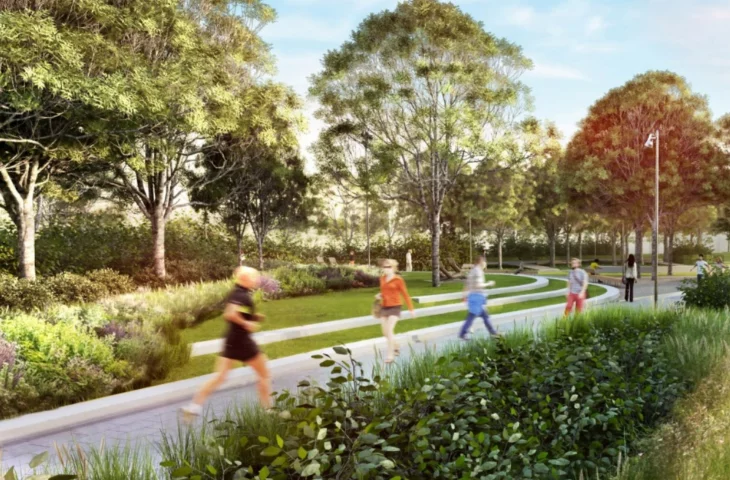The Warsaw Greenery Board has announced the start of work on the eagerly awaited Suwak Linear Park, to be built in Służewiec. The preliminary plan shows that it will be a green recreational area with a bike path and rain gardens. The tender for the design and construction of the park is expected to be announced later in July.
The creation of the Suwak Linear Park was proposed by the "Lepszy Służewiec" association as a response to requests from residents who needed a place for recreation, relaxation and meetings. Sluzewiec is part of the Mokotow district, which for many years lacked recreational green spaces. Instead, a large part of it was occupied by office buildings. In recent years, such an image of Mokotow and Sluzewiec has been changing. More and more housing estates have been built, and residents need well-organized and well-maintained spaces near where they live.
The Warsaw Greenery Board has responded positively to requests and has developed a preliminary plan for the park's construction. It shows, among other things, that construction work could begin as early as 2022 and be completed in 2023. A tender for both design and construction is to be launched soon. The Linear Park will be built as part of the "Linear Parks" investment task.
We didn't believe that we would get this far. That such a neglected space, which we see here today - these "bushes" or these paths, where it's a bit scary to walk, will become a viable place for residents in the future-- says Jakub Gladysz of the "Lepszy Sluzewiec" association.
space for recreation and rest
The park is to stand right on Suwak Street, between office buildings, a hotel and blocks of flats and the railroad line. The idea is for it to become a place full of greenery and aesthetically pleasing small architecture; conducive to relaxation and recreation.
The preliminary plan of the Warsaw Greenery Board calls for the 20,000-square-meter park to include mineral-paved alleys, rest areas and a bicycle path - which was particularly needed by residents.
It is crucial to reconcile the needs of different groups of residents, while at the same time ensuring their safety, so the alleys and the bike path will be clearly separated by a hedge of deciduous shrubs. The remnants of the allotment gardens - fences, foundations and an old summerhouse - will be removed , according to information from the Warsaw Greenery Board.
The ZZW announces that local residents will have an easier descent to the park from buildings slightly higher up, and people with disabilities will be able to use a ramp. In turn, after the walk, it will be possible to relax on one of the 60 benches, and outside on wooden deck chairs or hammocks. The entire park will be illuminated using photovoltaics and with a view to reducing light pollution.
The bike paths will be built with bituminous paving. The idea is that they will connect three districts: Ursynów, Mokotów and Ochota. The path will start at Suwak Street, near the Sluzewiec train station, and end at Woronicza Street. In addition, cyclists will be able to use new bicycle racks and shelters.
the power of greenery
Vegetation is to play a big role in the new Warsaw park! ZZW plans to plant about 50 trees, including 25 fruit trees. In addition, there will be field maple, Tartarian maple, small-leaved linden, hawthorns dicotyledon and scarlet, Swedish and common rowan, ornamental varieties of apple trees, bird cherry.
On an area of 4200 sqm, shrubs will be planted - derenes, forsythias, ligustrums, irises, hydrangeas, honeysuckles, jasmine trees, roses, lilacs and bladderworts. And 3,000 sqm will feature perennials and grasses. Of the ornamental grasses, there will be turf snail, reed canary grass and knapweed millet. It is worth noting that a flower meadow will be sown in the park, which will be a haven for pollinators - mowing here will be kept to a minimum , the ZZW announcement reads.
One of the more interesting solutions that will appear in the Linear Park will be rain gardens. They will be created in natural depressions in the area, and planted with vegetation adapted to periodic flooding conditions. Rain gardens are an example of a sustainable drainage system: they collect rainwater to gradually return it to the ecosystem.
elaborated: Katarzyna Domagała














